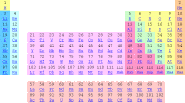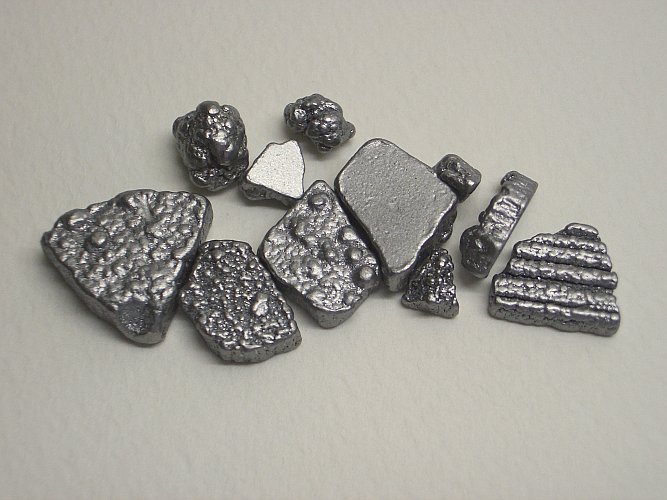


Iron
 Pure iron is a silvery gray/blue metal, which is oxidized easily.
It is slowly attacked by water, especially when the water contains some
dissolved electrolyte (e.g. salt). This attack of iron by water is the
well-known rusting of iron. By dilute acids, it is attacked more quickly.
Pure iron is a silvery gray/blue metal, which is oxidized easily.
It is slowly attacked by water, especially when the water contains some
dissolved electrolyte (e.g. salt). This attack of iron by water is the
well-known rusting of iron. By dilute acids, it is attacked more quickly.
The metal can be purchased in powder form from several vendors on eBay. This powdered metal can be interesting for many kinds of experiments with magnets, and it can be used as a source for creation of solutions of iron-salts. For the home chemist, however, it is more convenient to have a water-soluble compound of this metal at hand.
![]()
The most stable oxidation states of iron in its compounds are +2 and +3. Iron also can be brought to the +6 oxidation state in the so called ferrate ion and probably it exists in the +4 oxidation state as well in a transient state, on addition of hydrogen peroxide to a solution of an iron (II) salt.
The general public has access to quite a large number of iron compounds. This is due to the fact that iron salts are used for many processes in photography, but also in other applications, such as ink-making, and old processes, such as making cyanotypes. For the home chemist it is not necessary to have all these iron compounds at hand. Having one soluble iron (II) compound and one iron (III) compound, plus the hexacyanoferrates is sufficient.
Below follows a list of available iron-compounds:
- ferrous sulfate heptahydrate, FeSO4·7H2O
- ferrous ammonium sulfate, Fe (NH4)2 (SO4)2·6H2O
- ferric sulfate, Fe2 (SO4)3
- ferric ammonium sulfate, Fe NH4 (SO4)2·12H2O
- ferric chloride hexahydrate, FeCl3·6H2O
- ferric oxide, Fe2O3
- ferrous sulfide, FeS
- potassium hexacyanoferrate (II), pot. ferrocyanide, K4Fe(CN)6·3H2O
- potassium hexacyanoferrate (III), pot. ferricyanide, K3Fe(CN)6
- "ferric ammonium citrate", brown, Fe3+ / NH3 / NH4 / C6H5O73-
- "ferric ammonium citrate", green, Fe3+ / NH3 / NH4 / C6H5O73-
- "ferric ammonium oxalate", (NH4)3 [Fe(C2O4)3]
- "ferric oxalate", Fe [Fe(C2O4)3]
![]() Ferrous sulfate is available in many grades. The commercially available compound
usually is a greenish crystalline solid with a yellow/brown tinge. This is
fairly impure ferrous sulfate, which also contains quite some basic ferric
sulfate. For certain experiments with iron (II) this is OK, but frequently, this
chemical contains too much iron (III), to be really useful. Ferrous sulfate does
not keep well. The pure compound, which is light blue/green, quickly becomes
covered by a greenish/brown crust, due to oxidation by oxygen from the air.
Solutions of ferrous sulfate are very prone to aerial oxidation. Ferrous
sulfate, technical grade, is available from pottery and ceramics shops and from
photography raw chemical suppliers. The pure stuff is available from chemical
supply houses, but the purchase of the latter is not recommended due to its bad
storage properties.
Ferrous sulfate is available in many grades. The commercially available compound
usually is a greenish crystalline solid with a yellow/brown tinge. This is
fairly impure ferrous sulfate, which also contains quite some basic ferric
sulfate. For certain experiments with iron (II) this is OK, but frequently, this
chemical contains too much iron (III), to be really useful. Ferrous sulfate does
not keep well. The pure compound, which is light blue/green, quickly becomes
covered by a greenish/brown crust, due to oxidation by oxygen from the air.
Solutions of ferrous sulfate are very prone to aerial oxidation. Ferrous
sulfate, technical grade, is available from pottery and ceramics shops and from
photography raw chemical suppliers. The pure stuff is available from chemical
supply houses, but the purchase of the latter is not recommended due to its bad
storage properties.
![]() A much better alternative for purchasing ferrous sulfate is the purchase of
ferrous ammonium sulfate. This salt, also known as Mohr's salt, keeps quite
well, provided it is stored in a dry place. It is light blue/green. Its
solutions also are prone to aerial oxidation, but not as strong as the solutions
of ferrous sulfate. The slight acidity, introduced by the ammonium ions,
provides a fairly good protection for the ferrous ions against aerial oxidation.
Mohr's salt is available from photography raw chemical suppliers as special
order item and from chemical supply houses.
A much better alternative for purchasing ferrous sulfate is the purchase of
ferrous ammonium sulfate. This salt, also known as Mohr's salt, keeps quite
well, provided it is stored in a dry place. It is light blue/green. Its
solutions also are prone to aerial oxidation, but not as strong as the solutions
of ferrous sulfate. The slight acidity, introduced by the ammonium ions,
provides a fairly good protection for the ferrous ions against aerial oxidation.
Mohr's salt is available from photography raw chemical suppliers as special
order item and from chemical supply houses.
![]() A nice source for ferric ions is ferric ammonium sulfate or ferric sulfate. The
solutions of these compounds are light brown/yellow and somewhat turbid, due to
hydrolysis of the iron (III) ions. Both salts are available from photography raw
chemical suppliers. Ferric ammonium sulfate dissolves in water easily. Although
ferric sulfate is more soluble than ferric ammonium sulfate, the dry salt
dissolves in water very slowly. Dissolving a spatula full of this in some water
may take many hours. Ferric ammonium sulfate is a crystalline solid, consisting
of large transparent crystals, which are pale violet/brown. Ferric sulfate is
sold as a dry compact powder, which is off-white.
A nice source for ferric ions is ferric ammonium sulfate or ferric sulfate. The
solutions of these compounds are light brown/yellow and somewhat turbid, due to
hydrolysis of the iron (III) ions. Both salts are available from photography raw
chemical suppliers. Ferric ammonium sulfate dissolves in water easily. Although
ferric sulfate is more soluble than ferric ammonium sulfate, the dry salt
dissolves in water very slowly. Dissolving a spatula full of this in some water
may take many hours. Ferric ammonium sulfate is a crystalline solid, consisting
of large transparent crystals, which are pale violet/brown. Ferric sulfate is
sold as a dry compact powder, which is off-white.
![]() Another alternative for ferric ions is ferric chloride. This dissolves in water
very well. It is sold in the form of yellow/brown beads, or as a concentrated
solution in water. The solid is deliquescent. It attracts water from the air
very easily. When ferric chloride is used, then the iron (III) ions are not
available as free ions, but coordinated to chloride ions. The chloro-complex of
iron (III) is yellow/brown. Formation of this complex can be observed nicely by
adding a solution of table salt to a solution of ferric sulfate or ferric
ammonium sulfate. Ferric chloride is available from electronics shops as a PCB-etchant.
Another alternative for ferric ions is ferric chloride. This dissolves in water
very well. It is sold in the form of yellow/brown beads, or as a concentrated
solution in water. The solid is deliquescent. It attracts water from the air
very easily. When ferric chloride is used, then the iron (III) ions are not
available as free ions, but coordinated to chloride ions. The chloro-complex of
iron (III) is yellow/brown. Formation of this complex can be observed nicely by
adding a solution of table salt to a solution of ferric sulfate or ferric
ammonium sulfate. Ferric chloride is available from electronics shops as a PCB-etchant.
![]() Ferric oxide is available from pottery and ceramics shops as a dark red/brown
crystalline powder. This crystalline solid is calcined ferric oxide. This
calcined oxide is quite inert. When some of this powder is added to concentrated
hydrochloric acid, then even after boiling for several minutes, only trace
amounts have dissolved. The calcined compound is so inert, that it hardly is
interesting for the home chemist.
Ferric oxide is available from pottery and ceramics shops as a dark red/brown
crystalline powder. This crystalline solid is calcined ferric oxide. This
calcined oxide is quite inert. When some of this powder is added to concentrated
hydrochloric acid, then even after boiling for several minutes, only trace
amounts have dissolved. The calcined compound is so inert, that it hardly is
interesting for the home chemist.
![]() A nice, but
dangerous, dry-chemical experiment, which can be conducted with the finely
powdered ferric oxide is the so called 'thermite' reaction with finely powdered
aluminium metal. Beware, temperatures reached in this reaction become
ultra-high, 2000+ °C and molten iron can be sprayed around!!
A nice, but
dangerous, dry-chemical experiment, which can be conducted with the finely
powdered ferric oxide is the so called 'thermite' reaction with finely powdered
aluminium metal. Beware, temperatures reached in this reaction become
ultra-high, 2000+ °C and molten iron can be sprayed around!!
![]() Ferrous sulfide is sold in the form of black lumps. It is not really interesting
for the purpose of studying iron chemistry, but it can be interesting for making
hydrogen sulfide gas with dilute hydrochloric acid. Making hydrogen sulfide with
ferrous sulfide is more convenient than making hydrogen sulfide with sodium
sulfide. It allows one to generate hydrogen sulfide at a more constant rate.
Ferrous sulfide is available from chemical supply houses. It also can be made
fairly easily by igniting a stoichiometric mixture of sulphur and iron powder.
This should be done outside on a concrete tile.
Ferrous sulfide is sold in the form of black lumps. It is not really interesting
for the purpose of studying iron chemistry, but it can be interesting for making
hydrogen sulfide gas with dilute hydrochloric acid. Making hydrogen sulfide with
ferrous sulfide is more convenient than making hydrogen sulfide with sodium
sulfide. It allows one to generate hydrogen sulfide at a more constant rate.
Ferrous sulfide is available from chemical supply houses. It also can be made
fairly easily by igniting a stoichiometric mixture of sulphur and iron powder.
This should be done outside on a concrete tile.
![]() Potassium ferrocyanide and potassium ferricyanide are used extensively in
photography and alternative processes. The ferricyanide can be purchased at
almost every photography raw chemical supplier. The ferrocyanide also is
available at many of these suppliers, certainly as a special order. These
chemicals form brightly colored precipitates with many metal-salts. This
property is exploited in photography in many toner solutions. On this site, a
treatise on ferrocyanide toners is given in the
photography section. Both of
these chemicals are a valuable addition to the home lab. These compounds do not
contain free iron ions and they also do not contain free cyanide ions. The
cyanide ions are bound to the iron-core very tightly. These compounds are not
very toxic. Even in dilute acids, the cyanide is not released easily.
Experimenting with these chemicals is quite safe. Only in hot or concentrated
acids, one must take into account the possible release of hydrogen cyanide.
Potassium ferrocyanide and potassium ferricyanide are used extensively in
photography and alternative processes. The ferricyanide can be purchased at
almost every photography raw chemical supplier. The ferrocyanide also is
available at many of these suppliers, certainly as a special order. These
chemicals form brightly colored precipitates with many metal-salts. This
property is exploited in photography in many toner solutions. On this site, a
treatise on ferrocyanide toners is given in the
photography section. Both of
these chemicals are a valuable addition to the home lab. These compounds do not
contain free iron ions and they also do not contain free cyanide ions. The
cyanide ions are bound to the iron-core very tightly. These compounds are not
very toxic. Even in dilute acids, the cyanide is not released easily.
Experimenting with these chemicals is quite safe. Only in hot or concentrated
acids, one must take into account the possible release of hydrogen cyanide.
![]() The "ferric ammonium citrates" also are used extensively in photography and
alternative processes. These compounds also are used in medicine for treating
iron-deficiency. Ferric ammonium citrate is not a well defined compound of fixed
stoichiometry. It can be regarded as a compound, containing ferric ion, ammonium
ion, free ammonia, and citrate ion at variable ratio. The citrate ions at least
partially are coordinated to the ferric ions. The green compound has a lower
iron content and has a somewhat higher ammonium content than the brown compound.
It is slightly more acidic in its solutions. "Ferric ammonium citrate" is not
the first iron compound to start with. If one wants to study the chemistry of
iron, then the sulfates and to a lesser extent the chloride are more suitable.
The presence of the citrate ion has a strong influence on the observed
chemistry.
The "ferric ammonium citrates" also are used extensively in photography and
alternative processes. These compounds also are used in medicine for treating
iron-deficiency. Ferric ammonium citrate is not a well defined compound of fixed
stoichiometry. It can be regarded as a compound, containing ferric ion, ammonium
ion, free ammonia, and citrate ion at variable ratio. The citrate ions at least
partially are coordinated to the ferric ions. The green compound has a lower
iron content and has a somewhat higher ammonium content than the brown compound.
It is slightly more acidic in its solutions. "Ferric ammonium citrate" is not
the first iron compound to start with. If one wants to study the chemistry of
iron, then the sulfates and to a lesser extent the chloride are more suitable.
The presence of the citrate ion has a strong influence on the observed
chemistry.
![]() The "ferric oxalates", like the citrates, also are used extensively in
photography and alternative processes. "Ferric ammonium oxalate" is a well
defined compound, which, however, does not contain free ferric ions. The correct
name for this compound is ammonium trisoxalato-ferrate (III) and in aqueous
solutions it contains Fe(C2O4)33-
ions. "Ferric oxalate" is not a well-defined compound. The most pure compound
can be regarded as ferric trisoxalato-ferrate (III), but the commercial
preparations usually contain appreciable amounts of oxalic acid. As the
citrates, these compounds are not the most suitable when one wants to study the
properties of iron in its aqueous solutions. The chemistry of trisoxalato
ferrate (III) differs considerably from the chemistry of free iron (III) and
free oxalate.
The "ferric oxalates", like the citrates, also are used extensively in
photography and alternative processes. "Ferric ammonium oxalate" is a well
defined compound, which, however, does not contain free ferric ions. The correct
name for this compound is ammonium trisoxalato-ferrate (III) and in aqueous
solutions it contains Fe(C2O4)33-
ions. "Ferric oxalate" is not a well-defined compound. The most pure compound
can be regarded as ferric trisoxalato-ferrate (III), but the commercial
preparations usually contain appreciable amounts of oxalic acid. As the
citrates, these compounds are not the most suitable when one wants to study the
properties of iron in its aqueous solutions. The chemistry of trisoxalato
ferrate (III) differs considerably from the chemistry of free iron (III) and
free oxalate.